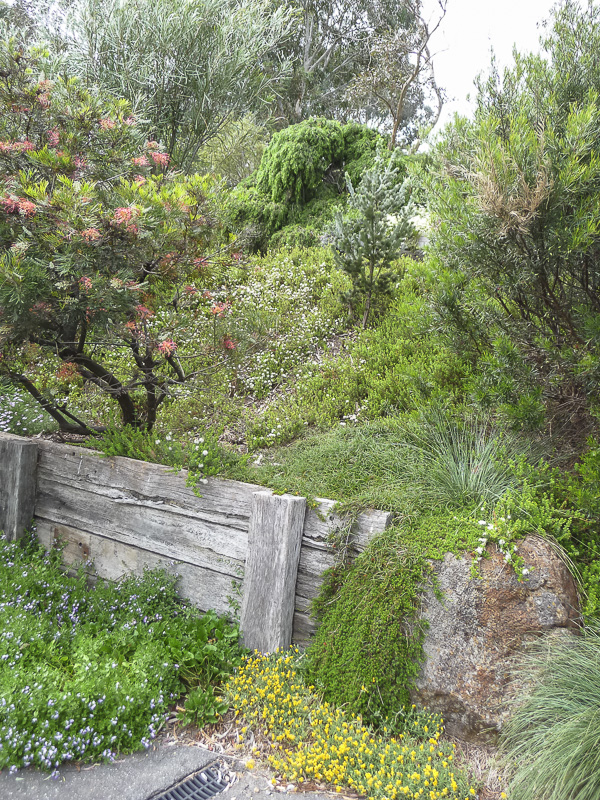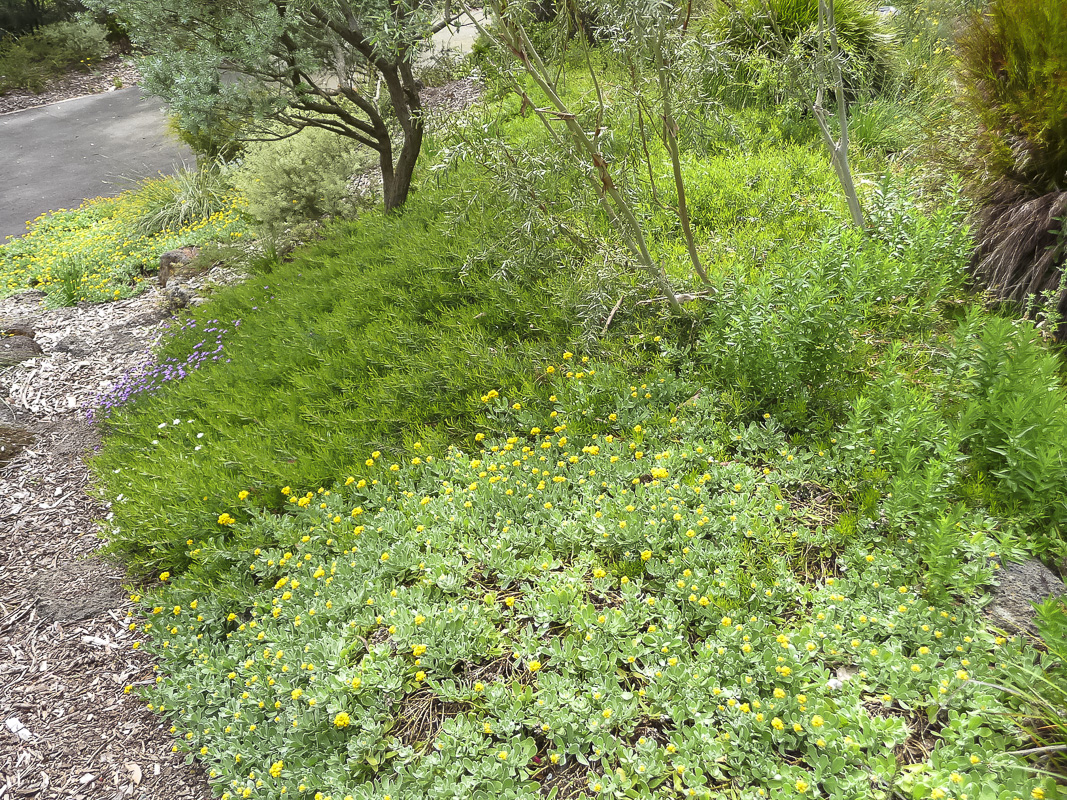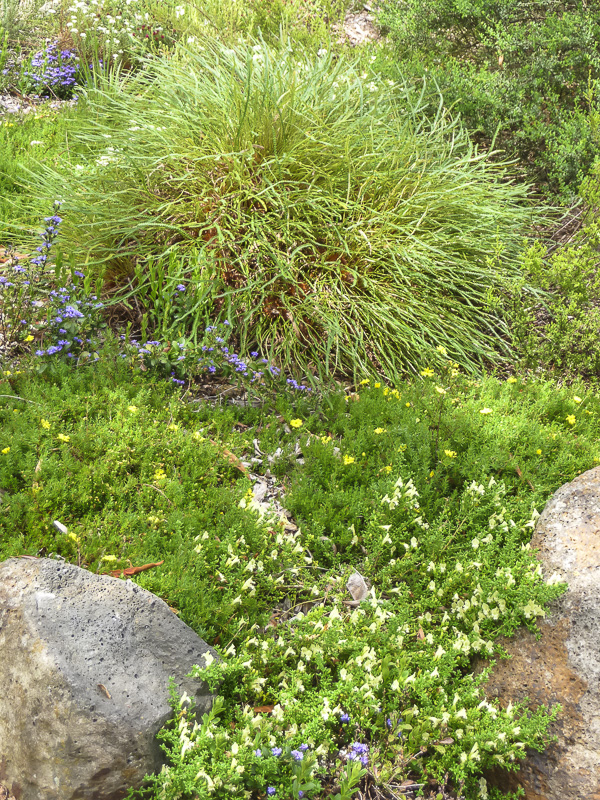Not only are native groundcovers highly practical, they also play an important role in garden design.
Australia has a wealth of choice of groundcovers
Is Australia over-endowed with ground-covering plants, or does it just seem that way to me!
I have been told that South Africa (and maybe other parts of the world) have more groundcovers than Australia. Regardless of that, there is a wealth of choice of native groundcovers and prostrate plants in Australia. Native groundcovers are valuable for both practical reasons as well their use in garden design.
Defining a groundcover
I’m not going to attempt to define what a ground covering plant is because there is quite a lot of variation in growth habit. Some mat the ground, some are very ground hugging, and others that are not ground hugging, nevertheless spread out rather than grow up. Some plants are categorised as groundcovers pure and simple, but others are really prostrate forms of larger shrubs.
My native garden location
I live on a north facing hillside south-east of Melbourne with clay soil and around 800mm of rainfall. My garden is very large – close to an acre or 0.4 of a hectare. I grow a great many different groundcovers because they are useful in helping me manage such a large garden. I also think they are such an important and interesting part of the success of the garden’s design.
Ground covering plants play a role in assisting a garden’s resilience to the hotter, windier, drier conditions expected as well as unpredictable high rainfall events.
Practical reasons to grow groundcovers
Here are the purely practical reasons for growing ground-covering plants. This is how they can assist you in the garden.

- Weed suppression – Make sure you have cleared the area of weeds first because it can be very difficult if not impossible to control weeds growing through a groundcover.
- Moisture retention – Groundcovers shade the ground. In doing so they shade their own root systems and/or the root systems of plants growing through them, from the drying effects of sun and wind.
- Sun and air – Groundcovers allow more sunlight and air movement through the garden, thus helping plants to stay healthy.
- Protection of the soil’s delicate ecosystem – The soil is a complex microbiome. Protecting the soil protects the life forms in the soil that are so important for the health of a garden.
- Erosion control – Groundcovers slow the flow of water and help with stabilising slopes.
- Living mulch – Groundcovers are a living mulch replacing the need to keep renewing organic mulch, thus saving precious resources, time and money.
Shown above is range of plants covering slope and bordering driveway allowing through views and increased sense of space. They include: Kunzea pomifera coming down the slope along with Pultenaea pedunculata, Grevillea nudiflora, species of Brachyscome, Scaevola and Chrysocephalum above and below the wall. Image Chris Larkin
Groundcovers play an important role in garden design
Beyond the practical reasons given above, groundcovers are an essential element in garden design.
This is what really interests me. There are a lot of groundcovers to choose from. Which plants you use is a matter of matching the growth habit, foliage type, growing conditions and your personal taste to the vision of what you are trying to achieve in the garden’s design.
Here are some of the design functions that ground covering plants can help you realise.
- A balance of mass (shrubs etc) and void/open space. Using groundcovers allows a greater feeling of open space. Placed beside paths and driveways groundcovers will expand the visual width of paths/roads. (The opposite of being ‘shrubed in’ which in its extreme form is a high hedged maze or tunnel). Used more generally throughout the garden they will allow you to see more of your garden from any vantage point as you see into garden beds to the detail of plants and maybe even further to more distant views.
- A balance of light and shade. Ground covering plants allow more sunlight and air into an area so different light effects on flowers and foliage can be enjoyed and appreciated throughout the day and over the seasons
- Appropriateness to the site. You need to consider the scale of the plants in relation to your garden. On sloping sites you can use plants to mound and cascade down slopes, or simply cover the slope in a simple sheet of foliage. Think of how plants might surround, lap up against or drape themselves over rocks and sleeper walls adding to the drama, the lushness and the interest.
- Use complementary and contrasting foliages and even growth habits for harmony on the one hand and interest and variety on the other.
- Think of growing plants up through groundcovers. Simple groundcovers like Grevillea obtusifolia, which doesn’t flower well in my experience, makes a wonderful, lush groundcover like new mown grass with trunks growing through it.
My favourite native groundcovers
I have listed some of my favourite groundcovers below and how they are used in garden design. But in doing so I make a few disclaimers.
Disclaimers!!
- No matter what I have to say about the size, toughness, ease or difficulty of growing a particular plant there will be some people who will disagree with me because no two growing conditions – or indeed plants – are the same.
- I have a large garden and you may have a small one so the plants you chose to use should be appropriate to the scale of your garden.
- There are no shortcuts to gardening, which in this case is knowing which groundcover to plant where to place it. People who love gardening love this about gardening. What you can know or need to know knows no end. Gardening is as intellectual as it is physical! Enjoy the journey as the destination is elusive due to the dynamic nature of gardening and our own evolving understandings related to gardening.
- Visiting gardens is one the most powerful ways of learning about plants – their growth habit and dimension.
- There is only so much you can learn from someone else’s garden. Becoming intimate with your own garden throughout the year is extremely important. You need to know your soil, wet and dry areas, sunny and shady ones. Let your garden talk to you. It will tell you which plants are happy and you can build on this with the same plants (repetition is good) or ones that like similar growing conditions.

Some of my favourites
Kunzea ambigua prostrate. I have about 10. Mounding and cascading. Grows in tough conditions with respect to dry (but will take wet) and low light. Masses of white flowers in Spring.
Pultenaea pedunculata. Still have several large patches. A local variant now available at KES (Knox Environment Society) but common around the Bendigo area. Fine foliaged, layering habit, massed with small pea flowers in Spring. Fabulous down slopes and draped over rocks. Establishment time seems to be important – give a long lead into summer.

Grevillea obtusifolia. I have at least half a dozen. Not great for flowers but lush foliage with slightly broadleaf grass appearance. Enough uplift to catch the light. One plant goes a long way. Great down embankments and with plants growing through it.
Hibbertia pedunculata. I must have 20 or more of these plants. One growing at the base of a tree! How far will they layer and go? Who knows! Fine foliaged, can lightly mound, massed with large yellow flowers over a long period in Spring. More likely to flower with a decent amount of sun. I use this one as a grass replacement in smaller spaces.
Hibbertia pedunculata and Prostanthera serpyllifolia in the foreground. Image Chris Larkin
Myoporum parvifolium. Different forms that are flat to the ground and a coarser plant that is called ‘upright’ that rears up and gives the opportunity for a great play of light. I grow plants through the various forms so really treating it as a living mulch. Have good success with some Hovea plants in dappled shade through the upright form.
Goodenia ovata prostrate. Fat, round, serrated slightly fleshly leaf, small yellow flowers. Tough plant that layers and will spring back after any summer set-back.
Zieria prostrata. If this plant seeded as well in the ground as it does in pots I would be worried. Good hanging down a big pot or in the ground. Mounded to ½ meter it is tolerant to dry but more so if it gets shade. Nice dark green leaf, massed with small white/pink flowers in Spring.
Dodonaea procumbens. Nice bright dark green leaf making it a healthy lush looking shrub. Covers a wide area taking dry and sun. Not succeeded with this in complete shade.
Persoonia chamarpitys (soft needle fine leaf), P. mollis (broader leaf), P. oxycoccoides (small roundish leaf), P. nutans x oxycoccoides. Love the difference here in leaf and growth habit. Grow more for the foliage than flowers which are small yellow.
Lasiopetalum macrophyllum. Big furry grey leaf but Tassy form is smaller. Both have showy new growth. L. micranthum is compact and grows in a fair bit of shade. All can flower well but hidden underneath the plant. Again I’m interested in what these plants have to offer that is different.
Correas – prostrate alba has large greyish round leaves and open white flowers whereas Correa alba ssp pannosa eg‘Western Star Pink’ has small leaf and white flowers with pink centres. Both are excellent. C. reflexa forms like numularifolia are also good. Correas have suffered in recent years if exposed to too much sun on extreme days and they can also die in wet times. They like dry semi-shade.
Lysiopetalum involucratum. Not sold as a groundcover by it acts like one for me! Long flowering period and sporadic at other times. Grey leafed, pink flowers. I use it repeatedly as a key plant either side of one of my paths so it helps to tie the area together.
All those pretty herbaceous plants. Brachyscome, Helichrysum, Scaevola. They are often set back in summer but have a great ability to ‘come again’ when the rains do. The rewards are in the wonderful show of colour they provide so who can do without them! They are ‘cottagie’ and delightful and we must learn to admire their ability to regenerate and forgive them their time of stress induced retreat!
And so much more. There are a few banksias, like Banksia blechnifolia, B.petiolaris, B. repens – what great foliage difference here! Lots of different grevilleas, too many to name, different acacias and ground-matting plants like Dichondra repens and Pratia sp forms. Go forth and explore! Lighten and brighten your garden with the space that ground-covering plants can provide.
For more information about native gardening in Victoria and other parts of Australia, see the Australian Plant Societies pages.
For more information about plants and where they grow, see the plant profiles on this website. APS NSW also has an extensive plant database here.
 Australian Native Plants Society (Australia)
Australian Native Plants Society (Australia)